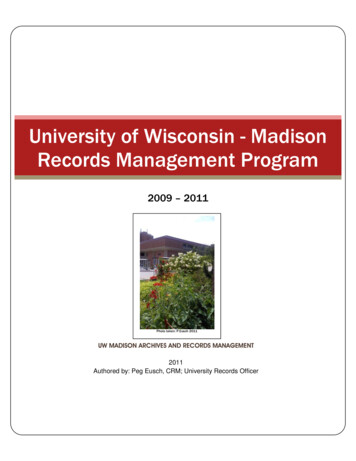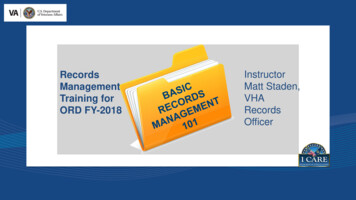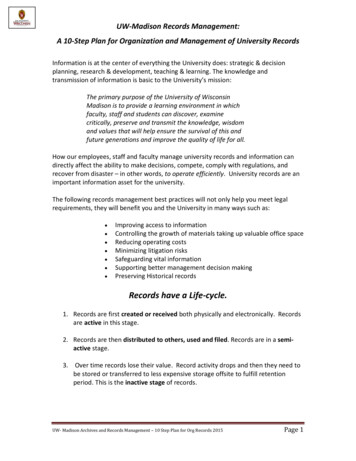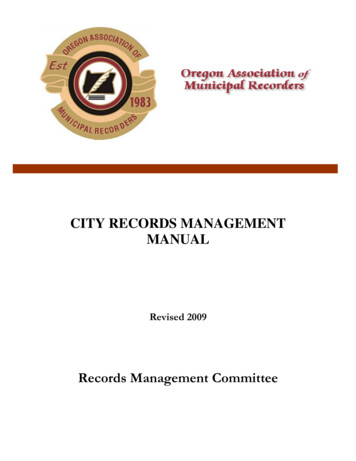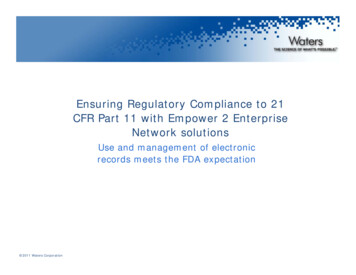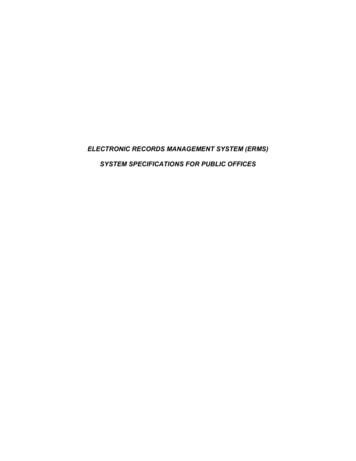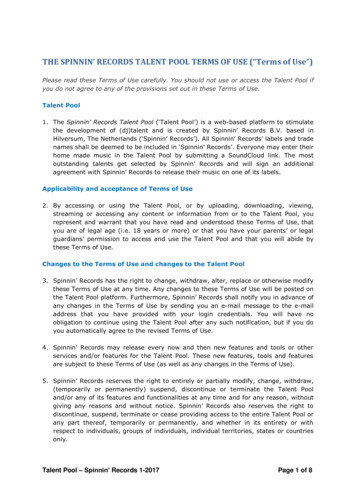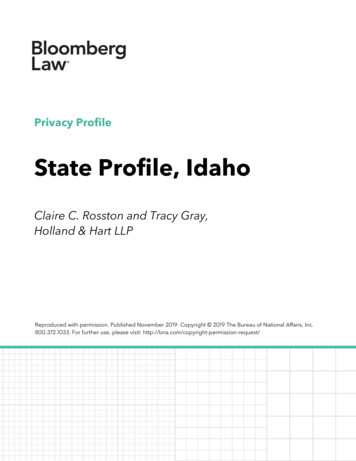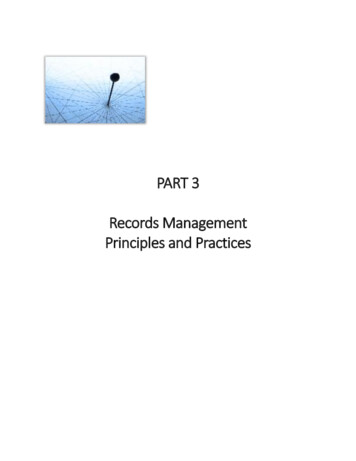
Transcription
PART 3Records ManagementPrinciples and Practices
PART 3:Records Management Principles and PracticesBefore we can travel on a journey, we need to know where we are going, and how to get there. We donot necessarily need to know how to draw a map ourselves, but we need to have a map available, andwe need to know how to read it. If we are driving ourselves, we do not need to know how our vehicleworks, but we do need to know how to drive it.The records management journey is similar. If our organization is going to reach the desired destinationof effective records care, everyone involved with making and keeping records needs to know whatrecords and evidence are, why it is important to manage them well, and how each person can supportthe goal of managing records to support effectiveness, efficiency, accountability, and transparency.This overview offers a brief outline of central records management principles and practices. It is therecords management equivalent of a driver’s manual: it offers some “rules of the road” for recordsmanagement. This overview will not teach you records or archives theories any more than a driver’smanual explains how a combustion engine is designed. The goal is to introduce some basic recordsmanagement concepts and outline some of the central practices of effective records management. Theprimary goal is to provide useful context to help you understand the importance of the milestones anddestinations in Part 4: the records management assessment tool.Therefore, the topics covered in this overview relate closely to the destinations in the Roadmap: What isa record, and what is records management? Why is records management important, especially in adigital age? What is the purpose of records management? What are the core actions in effective recordsmanagement? What is “good” records management?WHAT IS A RECORD?A record is a source of documentary evidence. It is a piece of proof.Just as we rely on maps to tell us where we are now and where we might go, we rely on records to tellus what our organizations have done or decided. We use records and other sources of evidence toexecute current actions, confirm past actions, and plan future actions.If we did not have access to records and other sources of evidence, we would not have any proof of ourplans, actions, or decisions. Organizations, especially those with public-sector responsibilities, needdocumentary proof. Personal assumptions or vague recollections do not allow organizations to workeffectively and efficiently, and they do not ensure organizations are accountable or transparent.Before we explain the importance of those principles – effectiveness, efficiency, accountability, andtransparency – we need to define evidence and records.Evidence is data, records, or other forms of recorded information deemed to be anobjective representation of actions, transactions, decisions, opinions, or ideas, and socan serve as a source of authentic proof.A record is information that has been captured on some fixed medium, which wascreated and kept, to support a government, organization, or individual to performactivities, remember events or information, and provide proof of decisions or actions.World Bank Group Records Management Roadmap, Part 3, p. 2
Evidence serves as proof – in judicial proceedings, in business planning, or in any other situations whereit is important to establish or confirm facts. Evidence can take the form of a written record – a letter, anemail, a report – or evidence can be found as elements in a database – names, addresses, payments,and so on. A record is a form of evidence, but it is not the only form of evidence.Records and evidence are also assets. They help an organization complete its daily operations, confirmdecisions, or uphold legal obligations or rights. If records and evidence are going to be useful assets,they must be protected so that they remain authentic and reliable sources of proof.INFORMATION AND EVIDENCE ARE DIFFERENTNot every piece of data or information is an authentic source of proof.The path from data to evidence is illustrated below.Data, from the Latin datum or “thing given,” is an element of raw content: a letter, asymbol, a number. The number “11-01-2020” is a data element.The number 11-01-2020, the data element, becomes information when it iscontextualized – when we realize that 11-01-2020 represents a day, month, and year.The information becomes evidence when we can confirm that it serves as authenticproof. When we see 11-01-2020 clearly written on the signature page of a contract, wecan prove the contract was signed on January 11, 2020.To determine if a piece of data or information is evidence, we need to ask this question: Can we confirmthat the information is authentic and reliable proof?Imagine your organization signs a contract with a supplier on January 11, 2020. The names, signatures,and date provide evidence that you and your supplier have agreed to the terms of the contract.You need to keep a copy of the contract, and so does the supplier. You both may need to refer to thecontract periodically to confirm the terms and conditions. You may be asked to revise the contract later,which means you will need your original as a source of information and evidence. Someday, perhaps,the contract will become part of your organization’s archives – a resource for historians and the publicto understand how your government carried out its business at some time in the past.Data, information, and evidence are not the same. This Roadmap focuses on issues associated withmanaging records and other sources of documentary evidence. Data management and informationmanagement are separate areas of expertise: important, but different from records management.THE FORM OF RECORDSRecords can come in any form.Not all records come in a “traditional” form: physical pieces of paper, bound reports, a black and whitephotograph, or a hand-drawn map. Videocassettes, reel-to-reel tape recordings, and films can also berecords – we refer to these types of evidence as analog or multi-media records. Records might also be inWorld Bank Group Records Management Roadmap, Part 3, p. 3
electronic form: computer files, data tapes, digital photographs, and so on. Data in databases canprovide proof, and so can email messages, social media posts, text messages, and Instagramphotographs. The challenge with managing records, especially in the 21st century, is distinguishingbetween valuable evidence and obsolete records or non-evidential data or information.Many other forms of evidence exist around the world, that do not fall easily into the definition ofphysical paper, analog or multi-media, or electronic. Oral traditions, stone carvings, woven beads, andcarved wood can all be defined as evidence, depending on why they were created and the kind ofinformation they hold.Whatever the form, a piece of evidence can hold information that might be needed as proof. That pieceof proof needs to be protected. Our focus in this Roadmap is primarily on physical, analog, andelectronic records, which are the common forms of record and evidence produced in organizationstoday. But the principles we outline in this tool also apply to the management of any other type ofdocumentary evidence.If something is intended to provide proof, it should be protected so it remains authentic and reliable.WHAT IS RECORDS MANAGEMENT?Records management ensures records and evidence remain authentic, safe, and usable.Records management is the process of ensuring that the evidence created, collected, and used by anorganization is created, managed, stored, and used in such a way that it remains authentic, safe, andusable, now and in the future.Records management allows organizations to establish strategies, policies, and procedures for making and keeping recordsallocate resources to manage records effectivelyensure records are accurate and reliable regardless of form or mediumcreate and manage records consistentlydistinguish between valuable and obsolete records and evidencestore records safely and dispose of records appropriately.Citizens and the public have a right to see evidence of an organization’s actions or decisions, especially ifthose actions or decisions affect someone’s life and welfare. To meet this responsibility, organizationsmust ensure their records are authentic and accessible for as long as needed, which may be forever.Records management helps organizations achieve their public responsibility by helping them managethe way they create, use, and keep records and evidence.World Bank Group Records Management Roadmap, Part 3, p. 4
WHY IS RECORDS MANAGEMENT IMPORTANT?Records management helps an organization be efficient, effective, accountable, and transparent.Organizations that develop and maintain a sound and well-planned records management program areefficient – they work at peak performance; they are effective – they accomplish tasks successfully; theyare accountable – they are able to justify their actions or decisions; and they are transparent – theyoperate in an atmosphere of openness and inclusiveness.Let us look again at the imaginary contract between your organization and a supplier, signed on January11, 2020. Records management helps you create, store, and retrieve that record effectively by helpingyou decide the following: naming conventions: how do you find the electronic copy of the contract if you name it“document” or “agreement” or “supplier contract”? metadata standards: how do you know if 11-01-2020 refers to DAY-MONTH-YEAR or MONTHDAY-YEAR? How can you find a record if the date is not clear? retention periods: how long do you need to keep the contract? What are the different legal oradministrative reasons for keeping it? storage: where is the contract kept – in a filing cabinet or computer? In which folder or drive? disposal: should you keep the contract permanently, or can it be destroyed when it is obsolete?It is not difficult to make these decisions and manage records effectively. But the decisions need to beconsistent, based on organizational needs, not individual preferences.But what happens when these decisions are not made? When everyone in the organization managesrecords their own way? One officer may keep all her records in the same computer folder and neverdeletes anything. Another may choose to destroy everything when he no longer needs to refer to them.Officials rarely choose to mismanage records. But without guidance, staff members are left to maketheir own decisions. Some will make effective decisions; others will not. The result is confusion and aloss of accountability and efficiency.RECORDS ARE ASSETSRecords and evidence are essential to an organization’s operations.Finances, employees, buildings, and equipment are all important resources for any organization. So arerecords and evidence. To ensure these resources are managed as assets, not liabilities, organizationsestablish structures and processes, rather than let officials act independently. To manage finances, organizations pay invoices on time and document and track expendituresconsistently. To manage staff, organizations follow clear hiring processes and regularly evaluate staffperformance.World Bank Group Records Management Roadmap, Part 3, p. 5
To manage buildings, organizations ensure they are well built in the first place and thenmaintain them, so they remain safe and strong. To manage equipment, organizations purchase the best items they can afford, maintain them ingood working order, and replace them when they become obsolete.Organizations need to execute similar actions to manage records. Establishing and maintaining a formalrecords management program ensures that records are treated as assets – which they are!THE BENEFITS OF RECORDS MANAGEMENTRecords management improves public accountability, enhances organizational efficiency, increasespublic access and transparency, and supports effective work practices.When an organization follows an effective and efficient records management program, it can locate an original signed agreement right away by filing it logicallyresume negotiations with a client easily by accessing a complete set of recordssend final annual reports to shareholders quickly by removing obsolete copies right awayprotect a citizen’s personal information by storing sensitive records safelyreduce storage costs by destroying obsolete records consistentlyremember past actions and decisions, allowing the organization to work more effectively.Without records management, organizations are vulnerable. We read news stories every day about datahacks, lost files, mismanaged government information, and breaches of personal privacy. Many of thesestories highlight weaknesses in the management of an organization’s records.The costs of poor records management are high. Resources are poorly used, staff cannot performeffectively, and the organization’s reputation is at risk. It does not have to be that way. We hope thisRoadmap will help your organization reduce your level of risk and improve your daily operations.IS INFORMATION TECHNOLOGY THE SOLUTION?Technology is not a solution; it is a reality.Computerization can save money, time, and space – if organizations use them effectively. Staff can usetechnology to work remotely, but only if electronic records are easy to access. Officials can accesscritical evidence online, but only if important records can be found easily. Organizations can shareinformation with the public quickly, but only if personal or sensitive records are adequately protected.To ensure information technologies improve daily business and protect evidence, organizations need toadopt systematic processes for managing the records and evidence created using those technologies.World Bank Group Records Management Roadmap, Part 3, p. 6
WHAT IS THE RECORDS LIFE CYCLE?Records need to be managed as a continuum of care across their life cycle.The life cycle of records is illustrated below.Records are destroyed or might be transferred toa separate archival agency, leaving the custodyand care of the organization.Obsolete or ArchivalObsolete records and evidencecan be destroyed;valuable records will be keptRecords and evidence are created orcollected, coming into the custody and careof the organization.Active or CurrentRecords and evidence areaccessed and used regularlyRecords classification schemesidentify where records arelocated, whether they arephysical, analog, or electronicRetention schedules anddisposal authorities ensurethe appropriate disposal ofinactive recordsInactive orNon-currentRecords and evidence are not usedregularly but may be needed forlegal reasons or periodic referenceThe Records Life CycleWorld Bank Group Records Management Roadmap, Part 3, p. 7
Organizations protect records and evidence by adopting a strategic approach to their care. A continuumof care is a consistent, policy-driven approach to the management of records. Decisions are planned, notad hoc; resources are sufficient; and all officials are committed to the same goal: the management ofrecords from beginning to end.The records life cycle represents that “beginning” and “end.” By adopting a life cycle approach,organizations apply effective processes from the moment actions are taken or decisions made, throughto the creation, use, and storage of records and evidence, to their ultimate disposition as obsoleterecords or as archives.WHAT ARE THE GOALS OF RECORDS MANAGEMENT?Records management supports the goals of efficiency, effectiveness, accountability, and transparency.To manage records as a continuum of care across the life cycle, organizations establish processesdesigned to achieve various goals. In this Roadmap, we have defined those goals as seven different butrelated destinations, as follows:Goal/Destination 1: recognizing the value of managing records effectivelyGoal/Destination 2: managing the records management program strategicallyGoal/Destination 3: committing sufficient resources to support records managementGoal/Destination 4: recognizing the link between records and information technologyGoal/Destination 5: managing records effectively and accountablyGoal/Destination 6: providing appropriate access to recordsGoal/Destination 7: storing records appropriately and disposing of them regularly.This Roadmap is designed to help your organization reach those goals/destinations by outlining specificmilestones to achieve for each destination. The milestones are outcomes – successful results of thework your organization carries out to improve its records management capacity.As we mentioned in the introduction, the Roadmap focuses on outcomes, not outputs. If the goal (thedestination) is managing records effectively and accountably, then a key objective (milestone) would beto identify and organize records. The two outcomes for that milestone would be (1) that records areidentified and (2) that records are organized. The outputs might be a records inventory – whichidentifies records and achieves the first outcome – and a classification scheme – which helps organizerecords and achieves the second outcome.The rest of this overview explains those destinations and milestones, to outline the core goals andobjectives of an effective and sustainable records management program.World Bank Group Records Management Roadmap, Part 3, p. 8
DESTINATION 1:RECOGNIZING THE VALUE OF MANAGING RECORDSEFFECTIVELYRecords management is valued by the organization.We cannot go on a journey if we cannot find the road. But we will not even want to go on the journey ifwe do not know what welcome views await us at the end. Similarly, we cannot build a path tosustainable records management if we do not understand how our organization will benefit.Destination 1, Milestone 1 is raising awareness of the value of records management.If an organization just places all old records in a storage locker instead of managing them effectively, itcannot retrieve legal agreements when they are needed. It cannot ensure staff pensions are paidbecause human resources files are inaccessible. It cannot prove it owns a building or piece of landbecause it cannot find certificates and title records. Change happens when organizations realize thebenefits of managing their evidence better. Change begins when awareness is raised.Destination 1, Milestone 2 is obtaining senior management support.Public officials want to do their jobs well, and they want to manage the documentary evidence of theirwork so they can access it easily again later. But if their efforts are not supported by seniormanagement, they will not be given the time and resources they need to work effectively. Awarenessneeds to be matched with firm and sustained support from those in decision-making positions.Destination 1, Milestone 3 is linking records management with legal, regulatory, and policyrequirements.Laws and regulations ensure that organizations remain accountable to the public. Financial managementlaws ensure departments do not overspend scarce resources. Military regulations ensure officials do notabuse their power. Procurement policies reduce the risk of corruption or fraud. Records help ensurethose laws, regulations, and policies are followed. Records provide evidence of compliance – or noncompliance – with formal requirements, ensuring those in power can be held to account.Destination 1, Milestone 4 is working with allied agencies.Publicly accountable organizations need to respect personal privacy and protect public safety. Managingrecords well supports access and privacy. Organizations are more effective when they work closely withallied agencies responsible for administering access, privacy, and security services, rather than makeindependent decisions that may contradict laws or regulations. Organizations also benefit byestablishing close working relationships with national or state archival institutions or other agenciesresponsible for preserving and making available records and evidence. Some organizational records havelong-term value; protecting them for the future benefits the organization and society.DESTINATION 2:MANAGING THE RECORDS MANAGEMENT PROGRAMSTRATEGICALLYRecords management is strategic.World Bank Group Records Management Roadmap, Part 3, p. 9
A driver cannot tune the car’s engine once but never check the oil again. Regular maintenance isessential. Similarly, an organization cannot impose a few records management processes now and notmaintain them. Strategic management supports a policy-based approach to records management.Establishing a strategic plan, developing policies and procedures, training and supporting staff, andmonitoring and auditing operations help organizations succeed with records management.Destination 2, Milestone 1 is developing a strategic plan.An organization plans a new building strategically to ensure that architectural drawings, engineeringplans, budgets, and time frames all work together. An organization should also build a recordsmanagement program by starting with a well-researched strategic plan. An effective, accountable, andtransparent records management program begins with a formal strategic plan.Destination 2, Milestone 2 is following records management policies and procedures.Organizations benefit from developing formal records management policies and procedures based onbest-practice standards. Policies and procedures are like a highway code. They help staff managerecords and evidence consistently, so the sources of proof remain authentic and reliable.Destination 2, Milestone 3 is confirming records management responsibilities for all staff.Staff need time, resources, and recognition to perform their records management duties. Defining staffresponsibilities helps achieve consistency. If everyone is given formal records management duties (andtrained adequately, as discussed in Destination 5), records operations improve significantly.Destination 2, Milestone 4 is monitoring and auditing records management operations.Monitoring and auditing help an organization assess its success with records management. Monitoring –an internal activity – assesses the organization’s compliance with legal or regulatory requirements andhow well the organization is performing records management tasks. Auditing – an external activity –looks identifies strengths and weaknesses that need to be addressed and changes that need to be madeto improve operations. Both monitoring and auditing help an organization reach its full potential.DESTINATION 3:COMMITTING SUFFICIENT RESOURCES TO SUPPORT RECORDSMANAGEMENTRecords management operations are adequately resourced.A train cannot run if there are no train tracks and no source of fuel. A records management program willnot “run” if is not supplied with adequate resources: finances, infrastructure, equipment, technology,and people. Organizations need to plan, obtain, and allocate the resources needed to ensure recordscan be created and protected appropriately.Destination 3, Milestone 1 is committing adequate financial resources.Records management programs need to be adequately and sustainably resourced. Funds are needed forstaff, buildings and storage areas, equipment and technology, and overhead costs such as light and heatWorld Bank Group Records Management Roadmap, Part 3, p. 10
and water. Providing adequate financial resources allows the organization to complete recordsmanagement operations successfully and demonstrates a commitment to records management.Destination 3, Milestone 2 is securing appropriate physical infrastructures, equipment, and technology.Paper/analog records need to be stored safely in file cabinets or storage rooms. Electronic records needto be kept in secure computer drives, with regular backups and up-to-date security controls. Planningand obtaining adequate physical infrastructures, equipment, and technology allows the organization toensure all records are managed effectively, no matter their form.Destination 3, Milestone 3 is employing qualified professionals.Everyone in the organization needs to support records management. But ideally, one individual – or oneteam of individuals – will oversee the program. Records management professionals bring expertise,training, and knowledge to the job, just as architects and engineers support building works, and doctorsand nurses provide expert medical care. Of course, other officials have an important role to play inrecords management, caring for their own records and evidence under guidance from experts.DESTINATION 4:RECOGNIZING THE LINK BETWEEN RECORDS ANDINFORMATION TECHNOLOGYRecords and information technologies are linked strategically.Most people in a city may ride bicycles to work, but the city may be planning to install a light railway toimprove travel for people in remote districts. Both forms of transportation are legitimate. Ensuring thatboth forms work together means planning growth strategically. Similarly, a records managementprogram may consist of “traditional” physical, analog, and multi-media records, but if the organizationwants to rely more heavily on electronic information technologies, it needs to plan that transitioneffectively. That work starts by recognizing the close link between records and information technology.Destination 4, Milestone 1 is managing records effectively regardless of form or medium.Records management professionals argue that “a record is a record is a record.” From a policyperspective, form or medium does not matter. What matters is that the evidence is protected so it canserve as a source of proof. The challenge is to establish strategies and practices that ensure the evidenceis protected, whatever its form. By managing records appropriately regardless of form, an organizationsucceeds with its records management goals and makes a smooth transition to an electronic workplace.Destination 4, Milestone 2 is selecting information technologies strategically.Making the transition to an electronic work environment means selecting information technologiesstrategically. Most computers, smartphones, personal digital assistants, cloud computing systems, orother tools and devices are used to create, manage, and access records and evidence. These tools needto be managed strategically so that the evidence they hold remains safe and accessible.World Bank Group Records Management Roadmap, Part 3, p. 11
Destination 4, Milestone 3 is collaborating with information technology providers.Close collaboration with information technology providers – such as officials in the organization whomanage computers or third-party suppliers of technology – helps ensure records and evidence remainauthentic, reliable sources of proof. No single person can address the records management implicationsof new technologies by themselves. Working as a team, and collaborating with specialists when needed,helps organizations plan strategically.DESTINATION 5:MANAGING RECORDS EFFECTIVELY AND ACCOUNTABLYRecords are managed consistently and strategically.Imagine if every person in the city were given a car, but no one knew how to drive a car, and there wereno rules about which side of the road to drive on? Chaos would ensue. A records management programwill not work if those involved are not given the tools they need to do their work. Important guidanceincludes duty to document requirements, inventories, classification schemes, metadata structures, andformal identification of record-keeping responsibilities. Once this guidance is in place, the organizationshould provide sustained staff support, including formal training and informal but consistent help.Destination 5, Milestone 1 is making records when needed.Duty to document requirements, usually bound in formal legislation, define records that must created.For example, an organization may comply with duty to document requirements by declaring that it willalways produce minutes of annual meetings, document financial expenditures, or record changes inland ownership. Duty to document policies emphasize not just record keeping but record making. Theyhelp agencies remain accountable, efficient, effective, and transparent. A record that exists is a recordthat can be used.Destination 5, Milestone 2 is identifying and organizing records.Creating and capturing/filing records should be done consistently and appropriately. Records inventoriesand classification schemes identify all existing records in the organization and then group them intocategories. For example, annual meeting minutes would be grouped separately from finance committeeminutes; human resource policy statements would be separate from monthly staff newsletters, and soon. When records are identified and classified, staff can manage them much more effectively.Destination 5, Milestone 3 is describing consistently.Capturing metadata – descriptive information such as names, titles, dates, and so on – allows records tobe identified clearly. Metadata conveys descriptive information consistently, confirming, for instance,that 11-01-2020 means January 11, 2020, not November 1, 2020. Metadata can also be added to arecord to indicate if it is an official version or reference copy. Capturing metadata and descriptiveinformation about records supports preservation and access.World Bank Group Records Management Roadmap, Part 3, p. 12
Destination 5, Milestone 4 is assigning responsibility for records.Staff also work more effectively if they know their responsibilities for managing records. Is their officethe Office of Primary Responsibility for a function, which means they will be in control of the records ofthat function? Who is the Official Record Holder – the person in the office responsible for managing thefiles of a project or initiative? Defining responsibilities allows staff to determine if the records in theirhands must be kept or can be destroyed, keeping records systems clear of unwanted du
World Bank Group Records Management Roadmap, Part 3, p. 2 PART 3: Records Management Principles and Practices Before we can travel on a journey, we need to know where we are going, and how to get there. We do not necessarily need to know how to draw a map ourselves, but we need to have a map available, and we need to know how to read it.
